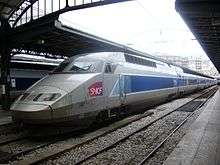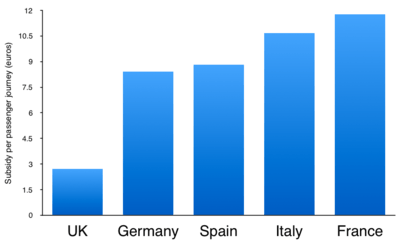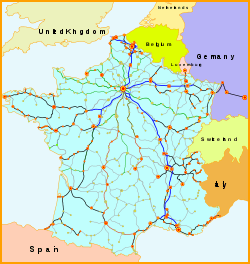Rail transport in France
Rail transport in France is marked by a clear predominance of passenger traffic, driven in particular by high-speed rail. The SNCF, the national state-owned railway company, operates most of the passenger and freight services on the national network managed by its subsidiary SNCF Réseau. France currently operates the second-largest European railway network, with a total of 29,901 kilometres of railway.[4].
| Rail transport in France | |||||||
|---|---|---|---|---|---|---|---|
 TGV at Paris-Est station | |||||||
| Operation | |||||||
| National railway | SNCF | ||||||
| Infrastructure company | SNCF | ||||||
| Major operators | Thalys, Lyria, Eurostar, RATP, Elipsos, ECR | ||||||
| Statistics | |||||||
| Ridership | 1,762 million (2017, SNCF[1] and RATP sections of RER[2]) | ||||||
| Passenger km | 100.2 billion (2017)[1][2] | ||||||
| Freight | 33.6 billion tonne-km (2017, SNCF and competitors[3]) | ||||||
| System length | |||||||
| Total | 29,901 kilometres (18,580 mi) [4] | ||||||
| Double track | 16,445 km (10,218 mi) | ||||||
| Electrified | 15,140 km (9,410 mi) | ||||||
| High-speed | 1,876 km (1,166 mi) | ||||||
| Track gauge | |||||||
| Main | 1,435 mm (4 ft 8 1⁄2 in) | ||||||
| High-speed | 1,435 mm (4 ft 8 1⁄2 in) | ||||||
| Electrification | |||||||
| 25 kV AC | 9,113 km (5,663 mi) | ||||||
| 1500 V DC | 5,905 km (3,669 mi) | ||||||
| other | 122 km (76 mi) | ||||||
| Features | |||||||
| No. tunnels | 1,300[5] | ||||||
| Tunnel length | 540 km (340 mi) | ||||||
| Longest tunnel | 50.5 km (31.4 mi) (Channel Tunnel) | ||||||
| Longest bridge | 2.178 km (1.353 mi) (Saint-André-de-Cubzac bridge) | ||||||
| No. stations | 3,054 (2009).[6] | ||||||
| Highest elevation | 1,593m (Yellow Train) | ||||||
| |||||||
The first rail line in the country opened in 1827 from Saint-Étienne to Andrézieux. The network has undergone a major modernization since 1981 with the arrival of the TGV high-speed rail service which has been consistently expanded in subsequent years.
In 2017, there were 1.762 billion journeys on the French national rail network, among which 1.270 billion on SNCF services[1] and 493 million on RATP sections of the RER[2], the express regional network operating in the Paris area which is shared between both companies. The Paris suburban rail services represents alone 82% of the French rail annual ridership[1][2].
With a total of 100.2 billion passenger-kilometres[1][2], France has the fifth-most used passenger network worldwide, and second-most used in Europe after that of Russia.[7] France is a member of the International Union of Railways (UIC). The UIC country code for France is 87.
National and regional services (TER) are complemented by an important network of urban rails which is still rapidly growing. Six cities are served by metro systems (Lille, Lyon, Marseille, Paris, Rennes and Toulouse). 28 metropolitan areas are additionally served by tram networks, among which 20 were inaugurated in the 21st century.
History
In 1814, the French engineer Pierre Michel Moisson-Desroches proposed to the Emperor Napoleon to build seven national railways from Paris, in order to travel "short distances within the Empire".
However, the history of railways in France really begins in 1827, when the first trains operated on the Saint-Etienne to Andrezieux Railway, the first French line, granted by order of King Louis XVIII in 1823.
Exploitation
Since Legrand Star rail plan of 1842, French railways are highly focused on Paris.
Traffic is concentrated on the main lines: 78% of activity is done on 30% of the network (8,900 km), and the 46% of smaller lines (13,600 km) only drive 6% of the traffic.[8] The 366 largest stations (12%) account for 85% of passenger activity, and the smallest 56% of stations take only 1.7% of traffic.[9]
Freight transport
Freight transport has declined since the early 1980s.[10] Today the network is predominantly passenger-centric.
Since 1 January 2007, the freight market has been open to conform to European Union agreements (EU Directive 91/440). New operators had already reached 15% of the market at the end of 2008.[11]
Passenger transport
Short and middle distance
The Transport express régional (TER) is directed by the administrative Regions of France. They contract with the SNCF for lines exploitation.
Long distance
The SNCF directly manage this class of trains. The TGV is used on the most important destinations, while Intercités carriages are still used for other lines.
Network
The French railway network, as administered by SNCF Réseau, as of June 2007, is a network of commercially usable lines of 29,213 kilometres (18,152 mi), of which 15,141 km (9,408 mi) is electrified. 1,876 km (1,166 mi) of those are high speed lines (LGV), 16,445 km (10,218 mi) dispose of two or more tracks. 5,905 km (3,669 mi) are supplied with 1,500 V DC, 9,113 km (5,663 mi) with 25 kV AC at 50 Hz. 122 km (76 mi) are electrified by third rail or other means.[4]
1,500 V is used on the south, and HSR lines and the northern part of the country use 25 kV electrification.
Trains drive on the left, except in Alsace and Moselle where tracks were first constructed while those regions were part of Germany.
Rail links to adjacent countries
- Same gauge
- Belgium — voltage change 25 kV AC/3 kV DC (except high-speed line to Brussels, same voltage)
- Germany — voltage change 25 kV AC/15 kV AC
- Great Britain via the Channel Tunnel — voltage change 25 kV AC/750 V DC third rail (except high-speed line to London, same voltage)
- Italy — voltage change 25 kV AC or 1.5 kV DC/3 kV DC
- Luxembourg — same voltage
- Monaco — same voltage
- Spain via the LGV Perpignan-Figueres — same voltage
- Switzerland — voltage change 25 kV AC or 1.5 kV DC/15 kV AC
- Break-of-gauge, 1,435 mm (4 ft 8 1⁄2 in)/1,668 mm (5 ft 5 21⁄32 in)
- Spain (on conventional tracks) — voltage change 1.5 kV DC/3 kV DC
- No rail link to Andorra
- No rail links from Saint Martin to Sint Maarten or from French Guiana to Suriname or Brazil
Current status
The French non-TGV intercity service (TET) is in decline, with old infrastructure and trains. It is likely to be hit further as the French government is planning to remove the monopoly that rail currently has on long-distance journeys by letting coach operators compete.[12]
Travel to the UK through the Channel Tunnel has grown in recent years, and from May 2015 passengers have been able to travel direct to Marseille, Avignon and Lyon. Eurostar is also introducing new Class 374 trains and refurbishing the current Class 373s.
The International Transport Forum described the current status of the French railways in their paper "Efficiency indicators of Railways in France":[13]
- The success of the TGV is undeniable (Crozet 2013). Work started in September 1975 on the first high-speed rail (HSR) line, between Paris and Lyon, and it was inaugurated in September 1981. New high-speed lines were opened in 1989 (towards the south-west), in 1993 (towards the north), etc. The high-speed network extent was 2,600 km in 2017, after the opening of four new lines.
- The regionalisation of intercity and local services was tested in 1997 and fully deployed in the early 2000s. Since then, TERs (regional express trains) have seen traffic rise steeply (50% between 2000 and 2013) as, to a lesser extent, have services in the Ile de France region (25%).
- Rail freight has been far less successful. The French network carried 55 billion tonne-km in 2001, but this figure scarcely reached 32 billion tonne-km in 2013. This weak performance contrasts sharply with the ambitious public policy of the last fifteen years. The Grenelle Environment Forum (2007–2010) oversaw the deployment of a costly freight plan that was no more effective than its predecessors.
Subsidies
Like roads, the French railways receive rail subsidies from the state in order to operate. Those amounted to €13.2 billion in 2013.[13]

Material
Alstom is the manufacturer of the TGV, and is behind many regional train models (Régiolis, SNCF Class Z 26500 ... )
See also
- Transport in France
- Narrow gauge railways in France
- Rail transport in Europe
- Rail transport by country
References
- "Memento statistiques SNCF Mobilités 2017" (PDF). La Plaine Saint-Denis, France: SNCF Mobilités. 2017. p. 14. Retrieved 2 May 2019.
- "Trafic annuel et journalier" (XLS). Paris, France: Observatoire de la mobilité en Île-de-France (Omnil). 2017. Retrieved 2 May 2019.
- "Memento statistiques SNCF Mobilités 2017" (PDF). La Plaine Saint-Denis, France: SNCF Mobilités. 2017. p. 39. Retrieved 2 May 2019.
- RFF Website "Network inventory" Archived 5 September 2007 at the Wayback Machine
- "Rapport sur la sécurité des tunnels routiers et ferroviaires francais". www.assemblee-nationale.fr.
- La Gare Contemporaine Archived 20 July 2011 at the Wayback Machine p94, Fabienne Keller
- "Transport - Passenger transport - OECD Data". OECD.
- Audit sur l'état du réseau national français p3, Robert Rivier & Yves Putallaz, 2005 September 7
- Gares et Connexion p20
- Pourquoi le fret ferroviaire va-t-il si mal en France? Autour du plan Véron (Fret 2006) Pierre Zembri 2004
- "La libéralisation des transports ferroviaires dans l'Union européenne". www.senat.fr.
- "France's loss-making inter-city services at a crossroads".
- "Efficiency indicators of Railways in France" (PDF).
External links
| Wikimedia Commons has media related to Rail transport in France. |
| Wikivoyage has a travel guide for Rail travel in France. |
